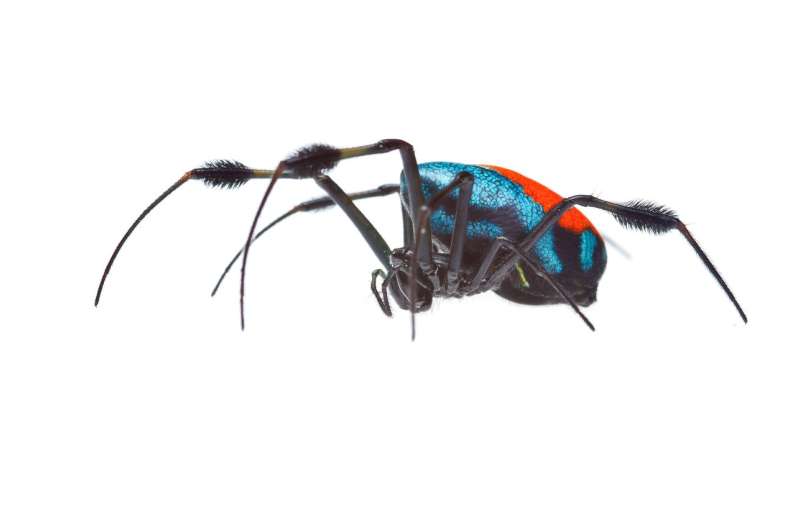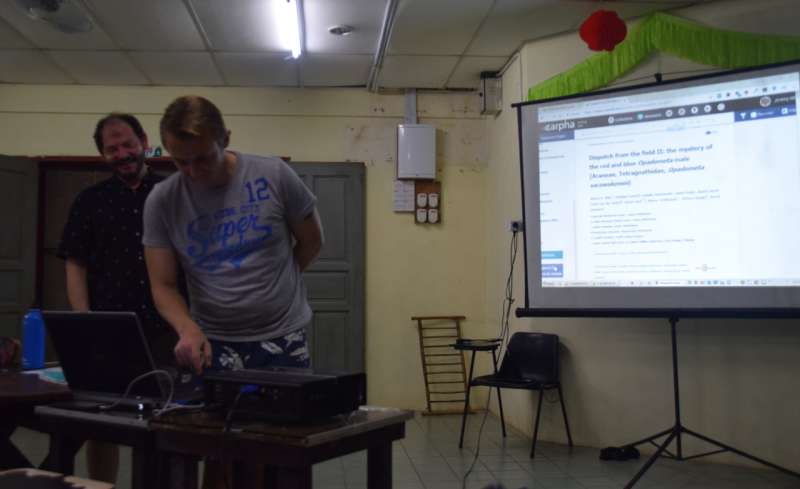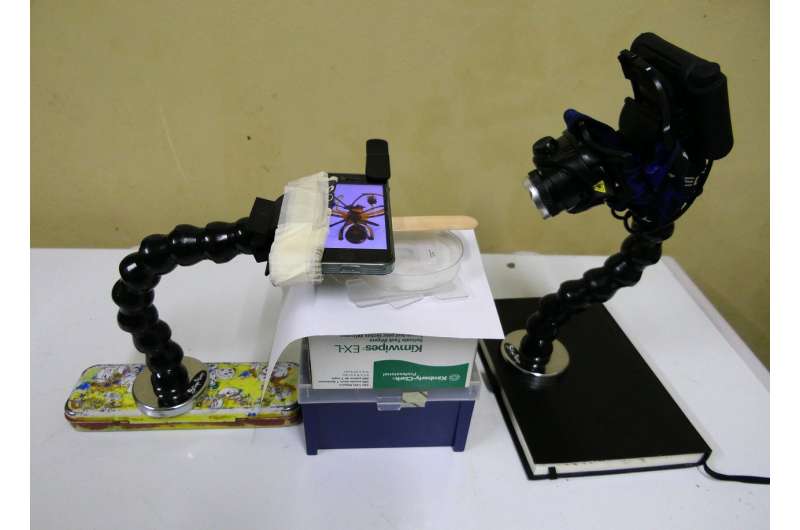Dispatch from the field II: Students describe an elusive spider while stationed in Borneo

A mystery has long shrouded the orb-weaving spider genus Opadometa, where males and females belonging to one and the same species look nothing alike. Furthermore, the males appear to be so elusive that scientists still doubt whether both sexes are correctly linked to each other even in the best-known species.
Such is the case for Opadometa sarawakensis—a species known only from female specimens. While remarkable with their striking red and blue colors and large size, the females could not give the slightest hint about the likely appearance of the male Opadometa sarawakensis.
Nevertheless, students taking part in a recent two-week tropical ecology field course organized by the Naturalis Biodiversity Center and Leiden University, and hosted by the Danau Girang Field Centre (DGFC) on the island of Borneo, Malaysia, found a mature male spider hanging on the web of a red and blue female, later identified as Opadometa sarawakensis. Still quite striking, the male was colored in a blend of orange, gray, black, and silver.
At the brink of a long-awaited discovery and eager to describe the male, the students along with their lecturers and the field station scientific staff encountered a peril—with problematic species like the studied orb weaver they were in need for strong evidence to prove that it matched the female from the web. Furthermore, molecular DNA-based analysis was not an option at the time, since the necessary equipment was not available at DGFC.

On the other hand, being at the center of the action turned out to have advantages no less persuasive than DNA evidence. Having conducted thorough field surveys in the area, the team has concluded that the male's observation on that particular female's web in addition to the fact that no other Opadometa species were found in the area, was enough to prove they were indeed representatives of the same spider.
Adapting to the quite basic conditions at the DGFC laboratory, the students and their mentors put in use various items they had on hand, including smartphones paired up with headlights mounted on gooseneck clips in place of sophisticated cameras.
In the end, they gathered all the necessary data to prepare the formal description of the newly identified male.
Once they had the observations and the data, there was only one question left to answer. How could they proceed with the submission of a manuscript to a scholarly journal, so that their finding is formally announced and recognised?

Thanks to the elaborated and highly automated workflow available at the peer-reviewed open access Biodiversity Data Journal and its underlying ARPHA Writing Tool, the researchers managed to successfully compile their manuscript, including all underlying data, such as geolocations, and submit it from the field station. All in all, the authoring, peer review and publication—each step taking place within the ARPHA Platform's singular environment—took less than a month to complete. In fact, the paper was published within few days after being submitted.
This is the second publication in the series "Dispatch from the field", resulting from an initiative led by spider taxonomist Dr. Jeremy Miller. In 2014, another team of students and their mentors described a new species of curious one-millimetre-long spider from the Danau Girang Field Center. Both papers serve to showcase the feasibility of publication and sharing of easy to find, access and re-use biodiversity data.
"This has been a unique educational experience for the students," says Jeremy. "They got to experience how tropical field biologists work, which is often from remote locations and without sophisticated equipment. This means that creativity and persistence are necessary to solve problems and complete a research objective. The fact that the students got to participate in advancing knowledge about this remarkable spider species by contributing to a manuscript was really exciting."
More information: Jeremy Miller et al, Dispatch from the field II: the mystery of the red and blue Opadometa male (Araneae, Tetragnathidae, Opadometa sarawakensis), Biodiversity Data Journal (2018). DOI: 10.3897/BDJ.6.e24777
Provided by Pensoft Publishers




















